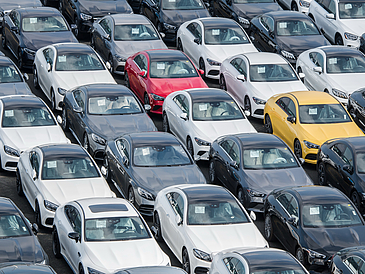The services provided at car ports span virtually the entire spectrum of vehicle logistics, from handling and storage to technical services. With 2.1 million vehicles in 2019, Bremerhaven car terminal is one of the largest car ports in the world. The terminal’s operations are highly complex and extremely dynamic, presenting major challenges with regard to process planning and control – the subject under investigation in the Isabella research project, which recently came to an end. The partners involved in the project are now continuing their successful collaboration with Isabella 2.0.
Rapid adjustment in line with current conditions
The Isabella project resulted in the development of an intelligent planning and control system for logistics processes and vehicle movements at sea and inland ports, which was tested in prototype form at the BLG car terminal in Bremerhaven. Planning is supported by an interactive, digital interface: a multitouch table visualises the terminal site in three dimensions. All of the relevant planning information, such as the utilization of the terminal, can be displayed at various levels of detail. The system makes it possible to analyse different planning scenarios using simulations and to present the results on the multitouch table.
With the aid of mobile data acquisition and real-time status reports, a control algorithm allows movement jobs to be allocated individually, thus optimising the travel paths and enabling a rapid response to changing conditions. The process of allocating jobs has been digitised. Movement jobs for vehicles at the terminal are assigned according to the location of the vehicles and drivers. The control algorithm was developed to manage this process and initial testing was carried out within a simulation environment which maps the terminal’s operations digitally. In the real-life system, communication between the control system and the car terminal personnel takes place via mobile apps. A new locating system was developed to determine the location of the vehicles.
The next step: expanding the system to cover all handling processes
The Isabella project focused on the processes at the terminal and on internal car movements. The aim of Isabella 2.0 is to integrate external modes of transport – trains, ships and lorries – with their loading and unloading processes and to systematically expand the control system and the simulation environment to cover all handling processes. This means that, in the future, more criteria relating to the current situation will be incorporated into the optimisation process, including the terminal utilization rate, mix of vehicles and staff capacities.
Key factor: workers in the field
Innovation projects work best when particular attention is given to the interface with the users right from the outset. As a result, from the beginning of the Isabella R&D work, there was a strong focus on the user-friendliness of the planning and control system and on integrating personnel into the development phase.
For the project partners, this is central to the success of the project: “To ensure greater acceptance of the new technology, employees need to be involved in the development processes, as some of the innovations mean major changes to the way they work.” The partners are therefore drawing on principles from the field of industrial and organisational psychology in order to involve the terminal staff in the design process for the new system. The Isabella 2.0 project will include the development of a virtual training application based on the multitouch table. Furthermore, the introduction of the new applications is to be supported by virtual reality (VR); for example, with the use of VR glasses.
Federal government adds EUR 2.5 million
The three-year project Isabella (full name: “Automobile logistics in sea and inland ports: interactive and simulation-based operation planning, dynamic and context-based control of device and load movements”), which was completed at the end of June, had a total project volume of EUR 3.7 million. It received funding amounting to EUR 2.6 million from the German Federal Ministry of Transport and Digital Infrastructure (BMVI) as part of the IHATEC funding programme for innovative port technologies and was supervised by project sponsor TÜV Rheinland. Follow-up project Isabella 2.0 has the title “Automobile logistics in sea and inland ports: integrated and user-oriented control of device and load movements through artificial intelligence and a virtual training application”. It will also run for three years and will again be supervised by TÜV Rheinland. It has a total volume of around EUR 3.6 million and will receive a further EUR 2.5 million from the BMVI’s IHATEC programme.
Further Information:
projekt-isabella.de und www.isabella2.de
www.biba.uni-bremen.de, www.blg-logistics.com
www.28apps.de
Contact:
Marit Hoff-Hoffmeyer-Zlotnik, M. Sc.
BIBA-Projektleiterin Isabella 2.0
BIBA – Bremer Institut für Produktion und Logistik
Telefon: (+49) 421 218-50 094
E-Mail: hhz@biba.uni-bremen.de

